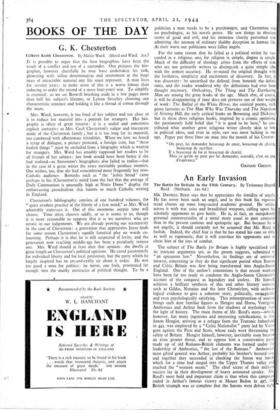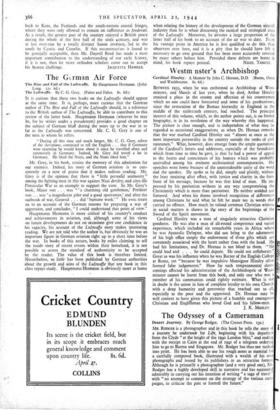An Early Invasion
The Battle for Britain in the Fifth Century. By Trelawney Dayrell Reed. (Methuen. Jos. 6d.) MR. DAYRELL REED says that he appreciates the timidity of angels. He has never been such an angel, and in this book his vigorous tread churns up some long-sacred academic ground. He strides across it with war cries and brandished weapons, calling upon his scholarly opponents to give battle. He is, in fact, an outspokenly personal controversialist of a metal more usual in past centuries than in the present cautious and apologetic age. But because he is not angelic, it should certainly not be assumed that Mr. Reed is foolish. Indeed, the chief fear is that he has stated his case so ably, as well as vigorously, that it will convince his opponents and so cheat him of the joys of combat.
The subject of The Battle for Britain is highly specialised and its intricate arguments are, as the proem suggests, submitted to " an epicurean few." Nevertheless, its findings are of universal interest, concerning as they do that significant period when Roman and Celtic Britain was first being transformed into Anglo,Saxon England. One of the author's contentions is that recent workers have been far too ready to condemn the Anglo-Saxon Chronicle's account of the conquest as legendary and useless. He himself achieves a brilliant synthesis of this and other literary 'sources, such as Gildas, Nermius and the later Chroniclers, with archaeo- logical evidence to give a coherent story, politically, strategically and even psychologically satisfying. This reinterpretation of sources brings such dear familiar figures as Hengist and Horsa Vortigem Ambrosius and Arthur back from the shadows of mythology into the light of history. The main theme of Mr. Reed's story—which, however, has many ingenious and interesting ramifications, is that Saxon Hengist, arriving as a refugee from the Teutonic fatherland in 443, was employed by a " Celtic Nationalist " party led by Vorti gem against the Picts and Scots, whose raids were threatening the safety of Britain. Hengist himself, however, inevitably soon became an even greater threat, and to oppose him a conservative par made up of old Romano-British elements was formed under the leadership of Ambrosius, " the last of the Romans." Ambrosius most gifted general was Arthur, probably his brother's bastard son, and together they succeeded in checking the Saxon war bands which for a time had surged into the Upper Thames valley an reached the " western ocean." The chief secret of their milita success lay in their development of heavy armoured cavalry. M Reed's most bold and important claim is that when this campai ended in Arthur's famous victory at Mount Badon in 497, th British triumph was so complete that the Saxons were driven ri back to Kent, the Fenlands and the south-eastern coastal fringes, where they were only allowed to remain on sufference as faederati. As a result, the greater part of the country enjoyed a British peace during the whole of the first half of the sixth century, and was at last over-run by a totally distinct Saxon invasion, . led in the south by Cynric and Ceawlin. If this reconstruction is found to be generally acceptable, then Mr. Dayrell Reed has made a most important contribution to the understanding of our early history, if it is not, then let more orthodox scholars come out to accept



























 Previous page
Previous page